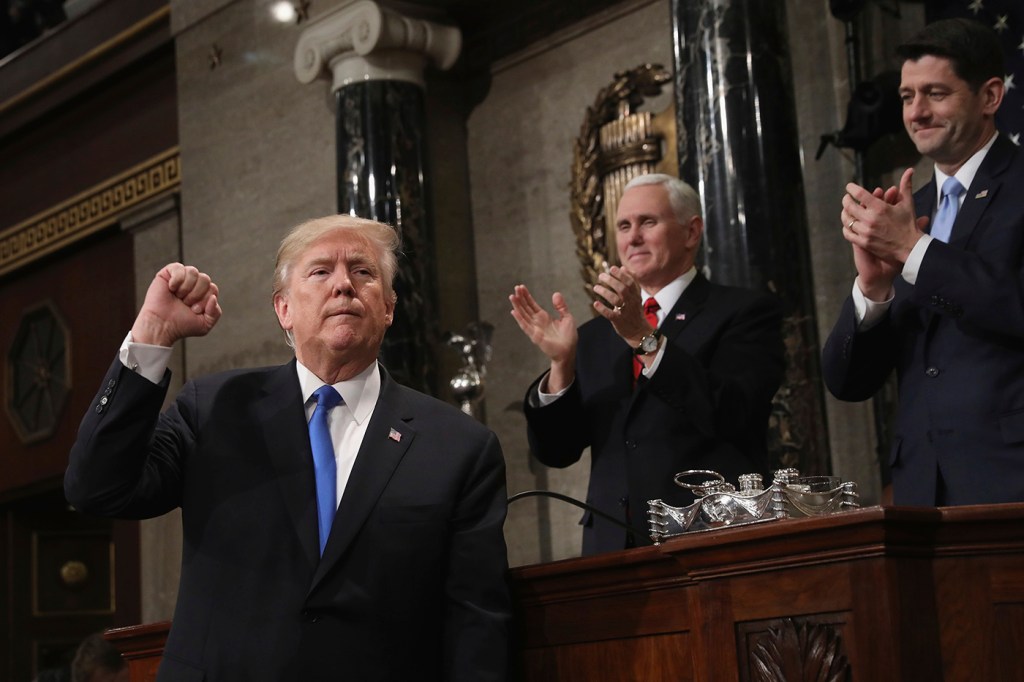Did we learn anything from Trump’s body language at SOTU?

It was hard not to notice President Donald Trump’s body language during his State of the Union address on Tuesday evening. Throughout his 80-minute speech, he frequently raised his eyebrows, lifted his chin, and angled his body to his left to face his supporters.
What do these nonverbal cues mean? According to Laura Dudley, assistant clinical professor of applied behavior analysis at Northeastern, the answer lies in the eye of the beholder.
“Do you like Trump?” she says. “Then his jutted chin probably signals to you that he is a strong leader. Do you hate Trump? Then his smile may signal to you that he is smug and self-serving.”
Is it possible to objectively assess Trump’s body language?
After a year of being in office, Trump has been on our TVs, on our radios, in our news feeds, and all over our social media. By now pretty much everyone has formed an opinion about Trump, and most of those opinions are strong. It may be difficult, but try to remember back to the first time you ever saw Trump. You probably didn’t have an opinion about him one way or the other. However, over time, Trump has been associated with many different statements, gestures, people, issues, and events that have likely led to some strong feelings. Whereas initially Trump was neutral, from a behavioral perspective the sight of Trump’s face or the sound of his voice may now serve as a conditioned stimulus.
For example, if you’ve been affected by Trump’s crackdown on undocumented immigrants, if you’re worried about his proposed changes to healthcare and how this may affect your family, then the very sight of Trump may elicit negative emotions such as anger or fear. On the other hand, if you’re a Trump supporter, if his message about putting America first has resonated with you, if you feel that Trump’s policies protect your job and your livelihood, then the sight of Trump may elicit positive feelings such as happiness or admiration.
As a result, it is difficult to provide an objective assessment of Trump’s body language during his State of the Union address. The way that we feel about Trump is likely to influence our perceptions of his language, whether that message is verbal or nonverbal.
What were some notable examples of Trump’s body language during the address—and what might they mean?
One thing that stood out was that Trump’s body was oriented toward the left side of the room throughout much of his address. This may have given the impression that he was speaking primarily to his supporters who were seated on that side of the room. However, Trump may not have been doing this intentionally. Rather, orienting himself toward the left may have been positively reinforced by the applause and smiles of his supporters, leading him to orient himself more toward their side. On the other hand, looking to the right side of the room would not have been reinforced, as it appeared that the people seated on that side were not clapping or smiling.
While speaking about tax reform, Trump not only turned to the left, but also reached both arms out toward the left, indicating that his side had accomplished this. On the other hand, he turned to the right when he described wage stagnation, suggesting that he blamed the previous administration—and Democrats—for this.
It was also notable that Trump clapped several times during his address. For example, he joined the applause when he first arrived at the podium. He also clapped in response to his own statements regarding deregulation, religious liberties, and the American flag. What’s more, his clapping only seemed to increase as his address went on. Though it is impossible to know exactly why he did this, it’s possible that he was reinforcing his own behavior by clapping for himself. Alternatively, he may have been prompting others to continue their applause.
Did we learn anything new from Trump’s body language during his address?
Maybe not. It’s important to remember that Trump’s address was written in advance. As would be expected, he probably practiced his delivery many times. His delivery was, for the most part, slow and deliberate, and he rarely veered off script. If Trump’s message resonated with you previously, it probably still does. If you avoided the address altogether because the sight of Trump elicits feelings of anger, you probably don’t have plans to watch it now.





